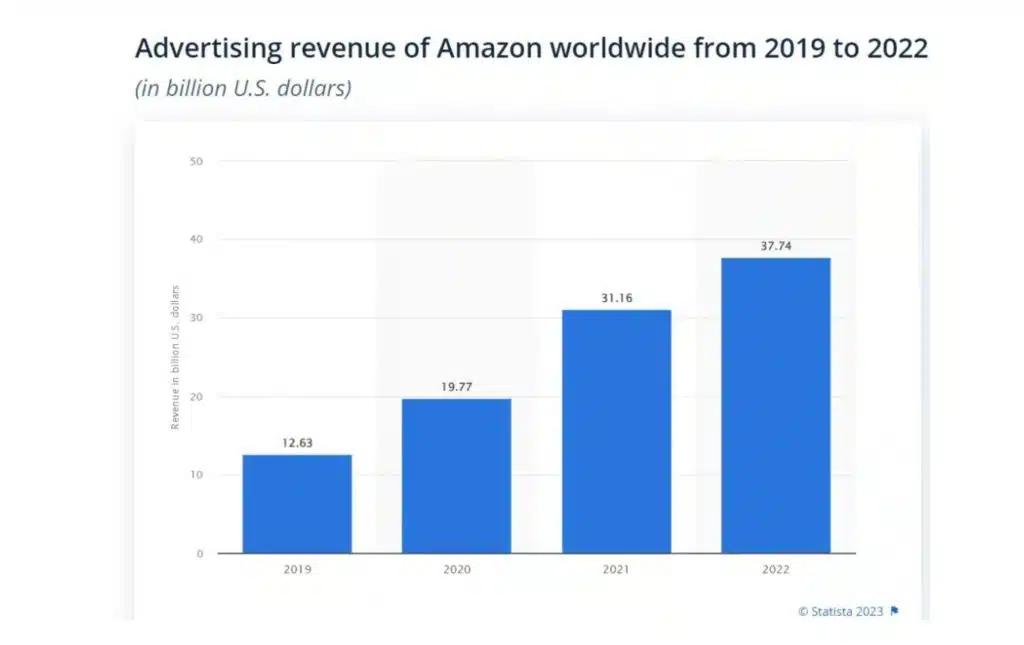What is the ROAS Formula? What is a good ROAS for Amazon?
Advertising is a powerful tool for Amazon sellers who want to reach relevant audiences and gain more brand exposure. Data from Statista reveals that Amazon earned $46.9 billion in ad revenue in 2023. This number accounts for 10.2% of total digital ad spending globally that year.

But alongside running ads on Amazon comes a big challenge: How can one ensure that they’re getting their money’s worth?
Enter the Amazon return on ad spend (ROAS) – a useful tool for any entrepreneur who wants to get a better grasp of the business’s marketing budget.
What is ROAS?
Let’s start with the ROAS definition. ROAS stands for Return on Ad Spend, a metric that measures the revenue generated for every amount spent on advertising.
By comparing the amount of money spent on a campaign against the income collected from it, you can gauge the effectiveness (or ineffectiveness) of their campaign. This metric is also crucial when bookkeeping your revenue.
Outside of Amazon, ROAS is also used across various digital marketing platforms such as Google, Facebook and Instagram.
Understanding TACoS on Amazon and AcoS metrics is essential for gaining a comprehensive view of a business’s financial health. Mastering the ROAS formula is equally crucial.
Here are the specific benefits of mastering ROAS:
Measuring Advertising Effectiveness
ROAS provides a clear picture of how well your ad investments perform. By comparing the revenue generated against the cost of ads, sellers can gauge the effectiveness of their campaigns.
A higher Amazon ROAS calculation indicates more efficient ad spending, whereas a lower ROAS signals the need for optimization.
Budget Allocation
By understanding the ROAS formula sellers can identify which campaigns are performing well and allocate more resources to those. At the same time, they can scale back or adjust their budget for underperforming campaigns.
This ensures that advertising budgets are utilized in the most cost-effective manner.
Related content: How Much do Amazon Ads Cost?
Profitability Insights
ROAS directly impacts profitability. By understanding the formula for ROAS, sellers can ensure that their advertising efforts contribute positively to their bottom line. This is particularly important for maintaining a sustainable business model in the competitive Amazon marketplace.
How to Calculate ROAS
Calculating ROAS is a straightforward process. To use the ROAS calculation formula, you need two key pieces of data:
- The total revenue generated from your ad campaigns.
- The total cost of those ad campaigns.
Here’s the return on ad spend formula:
Return on Ad Spend = (Revenue from Ads/Advertising Costs)
You can also add a x 100 to get an Amazon ROAS formula percentage rate rather than a ratio, such as this:

If you spent $1,000 on ads and generated $5,000 in revenue from those ads, your ROAS would be calculated as follows:
5,000 divided by 1,000 = 5
The ROAS formula computation above shows that for every dollar you spent on ads, you earned $5 in return.
Now if you apply the percentage ROAS formula (multiply by 100), you’ll get 500. This means that the amount you invested in ads grew by 500%.
Which ROAS Formula to Use?
Should you use the ROAS formula with x 100 or the one without? The choice between using a simple ratio or multiplying by 100 depends on what you’re using the metrics for:
- For internal analytics and detailed financial reporting, the basic ratio may suffice and provide precise insights.
- For presentations and communications with broader audiences, using the percentage format (multiplying by 100) can be more effective.
What is a Good ROAS?
Determining what constitutes a good ROAS can vary widely depending on several factors, such as industry, business goals, and advertising strategy.
Here are a few factors that could influence the ROAS you should be aiming for:
Industry Benchmarks
Different industries have varying standards for what is considered a good ROAS. Ecommerce businesses might aim for a higher ROAS compared to local service businesses, due to differences in profit margins and operational costs.
ROAS could also vary depending on the ad platform you’re using, as illustrated in this chart from Vibetrance:

Apparel and accessories, as well as toys and hobbies, seem to enjoy the highest ROAS. Google Paid Search, meanwhile, delivered the highest ROAS formula returns compared to Facebook and Instagram.
Business Objectives
The goals of your ads campaign also play a crucial role. If the objective is brand awareness rather than direct sales, a lower ROAS might be acceptable. Conversely, for campaigns focused on driving immediate sales, a higher ROAS is necessary to ensure profitability.
Profit Margins
Your specific profit margins will greatly influence what is considered a good ROAS. For businesses with high profit margins, even a lower ROAS might still be profitable. Conversely, businesses with thin margins will need a higher ROAS to cover costs and achieve profitability.
Using the ROAS formula effectively involves not just aiming for a high number. It’s also about understanding the context in which it is applied.
What is a Good ROAS on Amazon?
What is a good Amazon ROAS? The average ROAS on Amazon can vary significantly depending on several factors, including:
- Product category
- Competition
- Advertising strategies
Data from Statista based on a survey among Amazon advertisers in the US shows that 51% of third-party sellers said they saw a ROAS of 7x to 10x. On the other hand, 46% of wholesale suppliers had an average ROAS of around 4x to 6x.

According to Nozzle, an average Amazon ROAS is around 3x, while a good Amazon ROAS benchmark is around 6x. As previously established, however, this number could change significantly depending on various factors.
While the ROAS formula indicates the revenue generated per dollar spent on advertising, it doesn’t account for overall profitability. This can vary based on factors such as product costs, operating expenses, and profit margins.
One way to get a benchmark on what’s a good ROAS on Amazon is to compare your ROAS with the average score within your industry.
For instance, Scale Insights discussed a survey revealing that the average ROAS for US Amazon Sponsored Products ads stands at 3.3:1. This means for every dollar spent on advertising, brands get $3.3 in revenue.
How to Increase ROAS on Amazon
Here are a few ways to boost your ROAS on Amazon and set up your campaigns for success:
- Optimize Your Product Listings. Ensure your product listings are fully optimized with relevant keywords, high-quality images, and compelling product descriptions. Properly optimized listings improve the visibility and conversion rate of your ads.
- Use Targeted Advertising. Utilize Amazon’s targeting options to focus on the most relevant audience segments. This includes using Sponsored Ads to reach shoppers at different stages of the buying journey. Effective targeting can significantly enhance ad efficiency and increase ROAS.
- Adjust Bids Strategically. Take the time to track the performance of your ads and adjust your bidding strategy as needed. Increasing bids for high-performing keywords and reducing bids for low-performing ones can help maximize your return. You can also use automated bidding as part of your Amazon Sponsored Ads strategies.
- Focus on High-Converting Keywords. Keyword research is crucial to be able to use high-converting key terms that prospects are likely searching for. Integrate these keywords into your campaigns to attract more qualified traffic and improve conversion rates.
- Monitor and Analyze Performance Data. Track your performance to be able to see trends, improve, and adjust it as needed. Utilize Amazon’s advertising analytics tools to gain insights into your ad performance and make data-driven decisions to optimize your campaigns.
Frequently Asked Questions (FAQs)
Here are a few frequently asked questions about ROAS and the ROAS formula:
What is the perfect ROAS?
There is no universally “perfect” ROAS, as it varies depending on the business model and profit margins. However, a high ROAS, such as 10:1 or 1000%, is often considered excellent as it signifies a highly profitable campaign.
What ROAS is profitable?
A ROAS is profitable when it is greater than the break-even point, which depends on the business’s profit margins. Typically, a ROAS above 3:1 (300%) is considered profitable.
The Bottom Line
Mastering the Amazon ROAS formula is essential for any seller looking to optimize their ad spend and drive profitability. By understanding and applying the strategies discussed above, you can enhance your advertising efficiency and gain a competitive edge in the marketplace.
For expert guidance on creating a successful business on Amazon, schedule a call with AMZ Advisers, an Amazon seller consultant agency aimed at helping brands grow across the US, Europe, Canada, and Asia.
Author
 Carla Bauto Deña is a journalist and content writer producing stories for traditional and digital media. She believes in empowering small businesses with the help of innovative solutions, such as ecommerce and digital marketing.
Carla Bauto Deña is a journalist and content writer producing stories for traditional and digital media. She believes in empowering small businesses with the help of innovative solutions, such as ecommerce and digital marketing.



